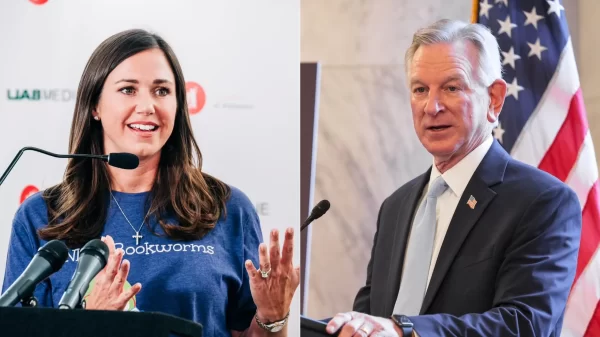With the start of Affordable Care Act open enrollment on November 1, ACA enrollees across the nation are facing soaring insurance costs. The start of open enrollment, which runs until December 15, marked a watershed moment in negotiations to end the federal government shutdown, which became the longest in U.S. history on Wednesday.
ACA enhanced Premium Tax Credits, ePTCs, were enacted by the American Rescue Plan Act in response to the COVID-19 pandemic, extended by the Inflation Reduction Act and set to expire at the end of 2025.
Congressional Democrats have demanded the continuation of the premium tax credits as a condition of voting to reopen the government and urged Republicans to negotiate a plan to extend before the start of open enrollment to avoid disruptions in ACA users’ 2026 plan application process.
More than 477,000 Alabamians are enrolled in ACA Healthcare Marketplace insurance plans, over 90 percent of whom receive subsidized coverage.
Healthcare nonprofit, the Kaiser Family Foundation, has projected that average Healthcare Marketplace premium payments will more than double in 2026, should ePTCs expire. KFF has also estimated that average premium payments for Alabamians would increase 93 percent, or from an average of $660 to $1,272, without access to subsidies.
Alabama’s marketplace enrollment has nearly tripled since the introduction of enhanced tax credits in 2020, and 98 percent of Alabama ACA enrollees receive subsidized coverage. The organization has also cautioned that without ePTCs, Alabama’s uninsured population is expected to increase by roughly 100,000 people by 2034.
Increased access to affordable care through the ACA has brought about a decrease in Alabama’s uninsured rate.
U.S. Census Bureau Data reports that roughly 10 percent of Alabamians under 65 years old were without health insurance in 2023, down from 14 percent in 2014, when ACA coverage was first made available in the state.
Among groups advocating for ePTC expansion in Alabama is the Cover Alabama Coalition, an alliance of over 100 health and community advocacy organizations dedicated to improving healthcare access in the state, run by Alabama Arise.
Debbie Smith, campaign director for Cover Alabama, told APR that, despite the start of open enrollment, she remains hopeful that public pressure will push Congress to extend the subsidies.
“I think we have to find a way forward,” Smith said. “It doesn’t matter that open enrollment started. It certainly is a setback, but too many people are suffering, and too many people are going to lose their health care coverage if this isn’t resolved.”
Smith emphasized that an end to ePTCs, and the resulting surge in uncompensated care, would not only impact subsidy recipients, but also the premium costs of all Alabamians and the overall stability of the state’s healthcare system.
“In the United States, we absolutely rely on each other having health coverage. If people don’t have health coverage and they show up to the ER, that results in uncompensated care costs, and so the hospital has to figure out a way to pay for that, and all this ends up being put back into higher costs for everybody else,” she said. “It doesn’t matter what kind of health coverage you have; those uncompensated care costs ultimately go back to the consumer.”
The anticipated end to ePTC access has already fueled increases in overall ACA premium costs.
Average 2026 Blue Cross of Alabama ACA premiums rates spiked 19.3 percent, compared to 2025, while United Healthcare increased by an average of 20 percent and Celtic Insurance Company by 25 percent.
Smith said that with the start of open enrollment, Cover Alabama has begun receiving testimonies from ACA enrollees dealing with premium increases.
She cited that one 38-year-old enrollee, not receiving ePTCs, reported a premium increase of $35 to $343 monthly.
“That’s really horrific,” she said. “If you’re paying about 35 bucks a month for health coverage right now, that means you’re in the lower income range. So, an extra 300 bucks a month is a huge deal, you know?”
Additionally, according to a report released last month by the Robert Wood Johnson Foundation, it is projected that Alabama healthcare providers would face a total of $939 million in losses in 2026, should ePTCs expire.
The Commonwealth Fund, meanwhile, has projected a GDP loss of $968 million for Alabama if the subsidies end, alongside the loss of over 9,000 jobs.
Smith went on to explain how the introduction of ePTCs helped many low-income Alabamians who still make too much money to qualify for Medicaid obtain access to health insurance.
“Since we’re in a state that hasn’t expanded Medicaid, the marketplace actually covers people that would be covered by Medicaid in the 40 other states,” she said.
In states that have expanded Medicaid, individuals who earn less than 138 percent of the federal poverty rate annually are eligible for Medicaid enrollment. However, in non-expansion states, such as Alabama, Medicaid recipients must earn less than the federal poverty rate to be eligible.
“Basically, we’re relying on this marketplace to fill in that part of the coverage gap,” Smith said. “It’s around 51 percent of enrollees that would actually qualify for Medicaid if they lived in a different state. So that’s why it’s incredibly important for us.”
Smith said she believes the beginning of open enrollment will increase public focus on ACA premium increases and pressure on Congress to act on the issue.
“We’re starting to get the real stories of people who are being impacted by it. I think one thing that was complicated beforehand was, you know, we could say, like, project how much things were going to cost and everything, but we didn’t have the real-world example, and now we have that data,” she said.
According to Smith, Cover Alabama received roughly 1,200 signatures on its petition calling on Congress to extend ePTC coverage.
However, although her organization has contacted Alabama’s federal lawmakers and urged them to take action to extend the subsidies, Smith said congresspeople have not pledged their intention to push for ePTC extension, except U.S. Representative Terri Sewell, D-Alabama, and U.S. Representative Shomari Figures, D-Alabama.
“We’re waiting to hear back, [from federal lawmakers] but the response from individuals and people calling on them is very, very high,” Smith said.
U.S. Senator Katie Britt, R-Alabama, said during an October appearance on CNN’s “State of the Union” that she was open to negotiating a plan to extend ePTCs, but called for reform of the subsidies.
“I’m absolutely open to having [a] conversation, but we’re not going to extend a program that is wrought with fraud, waste and abuse,” Britt said.
Meanwhile, on Thursday, the U.S. Senate Committee on Homeland Security and Government Affairs heard remarks from Brian Blase, the president of Paragon Health Institute, a think tank with close ties to the Trump administration, which released reports advocating against the continuation of ACA subsidies.
Paragon has argued that the subsidies are unfair to Americans who receive employer-based insurance at higher premiums and have accused the ACA Marketplace of facing wide-scale “enrollment fraud.”
Paragon’s reports on ACA coverage have drawn criticism from the American Hospital Association, which wrote that the organization’s accusations of fraud spring from “inaccurate data, dubious assumptions, and an apparent lack of understanding of how health insurance actually works. We set the record straight on each of their claims.”
In a written statement to APR, Alabama Hospital Association President and CEO Danne Howard expressed concern with how a rise in uncompensated care would impact Alabamians with chronic illnesses and the financial stability of the state’s healthcare system.
“Alabama already has among the highest uninsured rates in the nation, and uncompensated care is a chief financial strain on our hospitals,” Howard said.
“Working Alabamians will likely be unable to afford health coverage without premium assistance. Hospital emergency departments will become the only place they can turn for medical care,” she said. “That not only adds incredible financial stress to hospitals that are already operating on razor-thin or negative margins but also results in a loss of revenue for providers who have been reimbursed for the care provided to these individuals.”
“Chief among our concerns is the negative impact on the health and well-being of the individuals who, for nearly 5 years, have had health insurance that provided access to primary and preventive medical care and screenings,” Howard continued. “Some may have chronic conditions such as diabetes or cardiovascular conditions that have been monitored and stabilized through access to care and medications, but they may no longer be able to find or afford them. The long-term impact will be negative for hospitals, doctors, Alabama’s economy, and workforce.”
Additional nonprofit organizations that have called for the continuation of ePTCs, with the start of open enrollment, include the Center for American Progress, Keep Americans Covered, the National Partnership for Women and Families and the American Cancer Society Cancer Action Network.
“Congressional failure to act before November 1 will have damaging consequences for enrollment and, in turn, would drive up future years’ premium rates,” CAP wrote ahead of open enrollment. “Even if Congress does miss that critical date, tardiness is no excuse to continue denying millions of Americans more affordable health care.”
“Nearly everyone with Marketplace coverage will face a significant increase in their costs for next year, but those who currently rely on the enhanced premium tax credits will see massive spikes without action from Congress,” ACS CAN President Lisa Lacasse said. “Congress still has a chance to make this right and find a pathway to extend the tax credits before it’s too late. Many of their constituents’ lives depend on it.”



















































